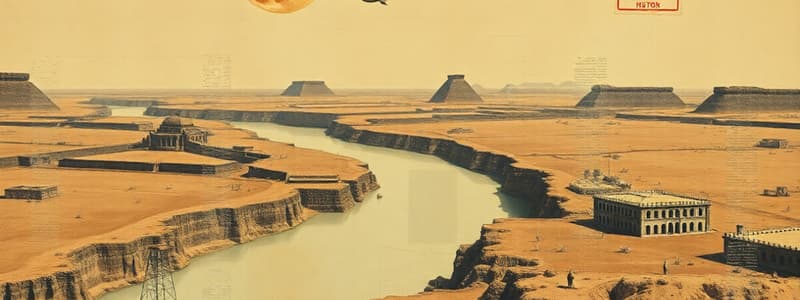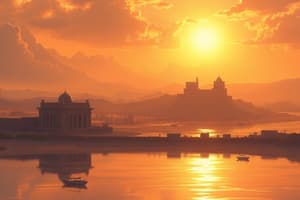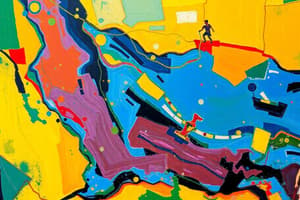Podcast
Questions and Answers
Mesopotamia means 'the land between two ______'
Mesopotamia means 'the land between two ______'
rivers
The Ishtar gate was built around ______ BCE
The Ishtar gate was built around ______ BCE
575
Sumer was the ______ of the Mesopotamian civilisation.
Sumer was the ______ of the Mesopotamian civilisation.
heart
The main cities of Mesopotamia included Babylon, Uruk, and ______.
The main cities of Mesopotamia included Babylon, Uruk, and ______.
The southernmost part of Mesopotamia was called ______.
The southernmost part of Mesopotamia was called ______.
Each city worshipped a god and had a ______ or temple tower.
Each city worshipped a god and had a ______ or temple tower.
The Mesopotamian civilisation began around ______ BCE.
The Mesopotamian civilisation began around ______ BCE.
Cyrus of Persia conquered the Mesopotamian kingdom around ______ BCE.
Cyrus of Persia conquered the Mesopotamian kingdom around ______ BCE.
Cuneiform derives from the words cuneus meaning ‘wedge’ and ______, meaning ‘shape’.
Cuneiform derives from the words cuneus meaning ‘wedge’ and ______, meaning ‘shape’.
The evolution of the cuneiform script took place from about 3000 BCE to ______ BCE.
The evolution of the cuneiform script took place from about 3000 BCE to ______ BCE.
Only a few were able to learn cuneiform, and those who did were known as ______.
Only a few were able to learn cuneiform, and those who did were known as ______.
Mesopotamians divided the sky into 12 parts, each named after a ______.
Mesopotamians divided the sky into 12 parts, each named after a ______.
The Mesopotamians used a ______ calendar, which was based on the movements of the Moon.
The Mesopotamians used a ______ calendar, which was based on the movements of the Moon.
The Mesopotamian lunar calendar was shorter by ______ days compared to the solar calendar.
The Mesopotamian lunar calendar was shorter by ______ days compared to the solar calendar.
The decline of the Mesopotamian civilization after 500 BCE was influenced by invasions from foreign groups like the ______.
The decline of the Mesopotamian civilization after 500 BCE was influenced by invasions from foreign groups like the ______.
The sudden change in the course of the ______ River contributed to the gradual drying up of the land.
The sudden change in the course of the ______ River contributed to the gradual drying up of the land.
The sacred part of the city served as the administrative ______ where storehouses and offices were located.
The sacred part of the city served as the administrative ______ where storehouses and offices were located.
The streets in the cities were often narrow and littered with ______.
The streets in the cities were often narrow and littered with ______.
Most houses had a central ______ with rooms surrounding it.
Most houses had a central ______ with rooms surrounding it.
Raw materials like mud, reeds, and palm trees were commonly used for ______.
Raw materials like mud, reeds, and palm trees were commonly used for ______.
The ______ was regarded as god’s representative on Earth.
The ______ was regarded as god’s representative on Earth.
The initial rulers of the cities were believed to be the ______.
The initial rulers of the cities were believed to be the ______.
The majority of the middle class included merchants, landowners, and ______.
The majority of the middle class included merchants, landowners, and ______.
The Mesopotamians devised an advanced system of perennial ______ for irrigation.
The Mesopotamians devised an advanced system of perennial ______ for irrigation.
Merchants transported goods like grain, wool, and textiles along with ______.
Merchants transported goods like grain, wool, and textiles along with ______.
The architecture of Mesopotamian civilization is considered to have been ______.
The architecture of Mesopotamian civilization is considered to have been ______.
The Mesopotamians are believed to be the first to use architectural structures like ______.
The Mesopotamians are believed to be the first to use architectural structures like ______.
The potter's ______ was first used in Mesopotamia to enhance pottery making.
The potter's ______ was first used in Mesopotamia to enhance pottery making.
The Mesopotamians developed the first form of ______ around 3000 BCE.
The Mesopotamians developed the first form of ______ around 3000 BCE.
Wheeled ______ were used for land transport in trade.
Wheeled ______ were used for land transport in trade.
The ancient Sumerians worshipped many ______, including gods associated with nature.
The ancient Sumerians worshipped many ______, including gods associated with nature.
The cuneiform script evolved from about 3000 BCE to 1000 CE.
The cuneiform script evolved from about 3000 BCE to 1000 CE.
The Mesopotamians divided the day into 24 hours as we do today.
The Mesopotamians divided the day into 24 hours as we do today.
The lunar calendar used by the Mesopotamians had 12 months and was longer than the solar calendar.
The lunar calendar used by the Mesopotamians had 12 months and was longer than the solar calendar.
The decline of the Mesopotamian civilization was partially due to the drying up of the land caused by river changes.
The decline of the Mesopotamian civilization was partially due to the drying up of the land caused by river changes.
The Mesopotamians had a solar calendar which they based on the movements of the Moon.
The Mesopotamians had a solar calendar which they based on the movements of the Moon.
Only a few scribes learned cuneiform, which had important roles in the government.
Only a few scribes learned cuneiform, which had important roles in the government.
Mesopotamians named the parts of the sky after constellations like Venus and Jupiter.
Mesopotamians named the parts of the sky after constellations like Venus and Jupiter.
The Mesopotamian civilization is regarded as one of the youngest among the ancient river valley civilizations.
The Mesopotamian civilization is regarded as one of the youngest among the ancient river valley civilizations.
The fertile crescent extends from the Persian Gulf to the Arctic Ocean.
The fertile crescent extends from the Persian Gulf to the Arctic Ocean.
Babylon was one of the main cities of Mesopotamia.
Babylon was one of the main cities of Mesopotamia.
The Mesopotamian civilization was ruled solely by the Assyrians throughout its existence.
The Mesopotamian civilization was ruled solely by the Assyrians throughout its existence.
Each city-state in Mesopotamia contained only one ziggurat.
Each city-state in Mesopotamia contained only one ziggurat.
Excavations in Ur revealed a lack of structured city planning.
Excavations in Ur revealed a lack of structured city planning.
The ziggurats were built of sun-baked bricks and could be seen for miles.
The ziggurats were built of sun-baked bricks and could be seen for miles.
Sumer was located in the northernmost part of the Mesopotamian region.
Sumer was located in the northernmost part of the Mesopotamian region.
Cyrus of Persia conquered the Mesopotamian civilization around 539 BCE.
Cyrus of Persia conquered the Mesopotamian civilization around 539 BCE.
The Mesopotamian civilization was known for its well-planned cities with wide, clean streets.
The Mesopotamian civilization was known for its well-planned cities with wide, clean streets.
The Mesopotamians were skilled in metallurgy and carpentry.
The Mesopotamians were skilled in metallurgy and carpentry.
Kings in Mesopotamia were seen as the ultimate authority and their positions were always hereditary.
Kings in Mesopotamia were seen as the ultimate authority and their positions were always hereditary.
The Mesopotamian irrigation system relied heavily on natural rainfall.
The Mesopotamian irrigation system relied heavily on natural rainfall.
Mesopotamia was the first known civilization to use iron for weapon making.
Mesopotamia was the first known civilization to use iron for weapon making.
Mesopotamian society was divided into distinct social classes including priests, merchants, and slaves.
Mesopotamian society was divided into distinct social classes including priests, merchants, and slaves.
The ox-drawn plough and wheeled carts were significant inventions in Mesopotamian agriculture.
The ox-drawn plough and wheeled carts were significant inventions in Mesopotamian agriculture.
Scribes in Mesopotamia were primarily responsible for military operations.
Scribes in Mesopotamia were primarily responsible for military operations.
The earliest form of writing used by the Mesopotamians included symbols representing specific objects.
The earliest form of writing used by the Mesopotamians included symbols representing specific objects.
Wheeled rafts, called keleks, were commonly used for land transport in Mesopotamia.
Wheeled rafts, called keleks, were commonly used for land transport in Mesopotamia.
The city of Mari is an example of Mesopotamian architecture featuring large public buildings.
The city of Mari is an example of Mesopotamian architecture featuring large public buildings.
Mesopotamians believed in life after death and often included items used in daily life in graves.
Mesopotamians believed in life after death and often included items used in daily life in graves.
Each city in Mesopotamia had a patron god to whom the city was dedicated.
Each city in Mesopotamia had a patron god to whom the city was dedicated.
The first known wheeled cart was invented by the ancient Egyptians.
The first known wheeled cart was invented by the ancient Egyptians.
The Mesopotamian civilization relied solely on agriculture with no significant trade activities.
The Mesopotamian civilization relied solely on agriculture with no significant trade activities.
Study Notes
Geography and Significance
- Mesopotamia, meaning "the land between two rivers", is located between the Tigris and Euphrates rivers, flowing from Turkey to the Persian Gulf.
- Bordered by the Arabian Desert to the west and the Iranian mountains to the east, Mesopotamia is recognized as the 'Civilisation of the Crescent'.
Historical Overview
- Mesopotamian civilisation emerged around 3500 BCE and persisted until approximately 500 BCE, initially ruled by the Sumerians.
- Sumer was the southern region and the heart of the civilisation; Babylonia was to the north, Akkad in the center, and Assyria in the northeast.
- Conquerors such as the Babylonians and Assyrians adopted and assimilated into the Mesopotamian culture.
City-States Structure
- Each city was a distinct city-state, controlling hundreds of square kilometers, prone to conflicts over resources and power.
- Major cities included Babylon, Uruk, Eridu, Lagash, and Ur, each with a sacred city area containing a ziggurat for worship.
- City layouts featured narrow streets, houses with central courtyards, and were built using mud, reeds, and palm trees.
Social Hierarchy
- Society was stratified; the king held top status, regarded as a representative of the gods.
- Priests held considerable power, possibly as initial rulers, followed by officers, scribes, merchants, landowners, craftsmen, and slave populations.
- The army was crucial due to constant threats from nomadic tribes.
Kingship and Governance
- Initially, priest kings ruled without hereditary succession; over time, kings were viewed as divine figures responsible for city defense and justice administration.
Economy and Agriculture
- Agriculture was the backbone of the economy with crops like wheat, barley, and fruits, aided by an advanced irrigation system utilizing canals.
- The ox-drawn plough and wheeled carts enhanced farming efficiency.
Trade Networks
- Extensive trade routes existed between Mesopotamia and foreign lands, with merchants traveling to the Mediterranean and eastern Africa.
- Key exports included grain and textiles; imports comprised metals and luxury items from India and beyond.
Architectural Achievements
- Noted for grand architecture with public buildings, parks, and intricate palace designs, exemplified by the Mari palace.
- Incorporated structural innovations like arches and columns, and excelled in metallurgy and carpentry.
Religious Beliefs
- Polytheistic society, worshipping various gods, including An, Enlil, Enki, and Marduk, with each city honoring a patron deity.
- Ziggurats served as temple structures where rituals and offerings were made regularly.
Technological and Cultural Contributions
- Invented the wheel and potter's wheel, enhancing transport and pottery production.
- Pioneered the use of metals for various artifacts and tools, including the early use of iron for weaponry.
- Developed cuneiform around 3000 BCE, evolving from pictograms to a more complex writing system.
Contributions to Astronomy and Timekeeping
- Mesopotamians created a system dividing the sky into 12 parts, naming constellations and establishing a 24-hour day structure.
- Utilized a lunar calendar, requiring intercalation of months to align with seasonal variations.
Decline of the Civilisation
- The decline after 500 BCE attributed to invasions by Persians, Greeks, and others; rising rival city-states; and environmental changes affecting agriculture.
- Despite its fall, Mesopotamian achievements influenced subsequent civilisations and laid groundwork for future developments in human history.
Geography and Significance
- Mesopotamia, meaning "the land between two rivers", is located between the Tigris and Euphrates rivers, flowing from Turkey to the Persian Gulf.
- Bordered by the Arabian Desert to the west and the Iranian mountains to the east, Mesopotamia is recognized as the 'Civilisation of the Crescent'.
Historical Overview
- Mesopotamian civilisation emerged around 3500 BCE and persisted until approximately 500 BCE, initially ruled by the Sumerians.
- Sumer was the southern region and the heart of the civilisation; Babylonia was to the north, Akkad in the center, and Assyria in the northeast.
- Conquerors such as the Babylonians and Assyrians adopted and assimilated into the Mesopotamian culture.
City-States Structure
- Each city was a distinct city-state, controlling hundreds of square kilometers, prone to conflicts over resources and power.
- Major cities included Babylon, Uruk, Eridu, Lagash, and Ur, each with a sacred city area containing a ziggurat for worship.
- City layouts featured narrow streets, houses with central courtyards, and were built using mud, reeds, and palm trees.
Social Hierarchy
- Society was stratified; the king held top status, regarded as a representative of the gods.
- Priests held considerable power, possibly as initial rulers, followed by officers, scribes, merchants, landowners, craftsmen, and slave populations.
- The army was crucial due to constant threats from nomadic tribes.
Kingship and Governance
- Initially, priest kings ruled without hereditary succession; over time, kings were viewed as divine figures responsible for city defense and justice administration.
Economy and Agriculture
- Agriculture was the backbone of the economy with crops like wheat, barley, and fruits, aided by an advanced irrigation system utilizing canals.
- The ox-drawn plough and wheeled carts enhanced farming efficiency.
Trade Networks
- Extensive trade routes existed between Mesopotamia and foreign lands, with merchants traveling to the Mediterranean and eastern Africa.
- Key exports included grain and textiles; imports comprised metals and luxury items from India and beyond.
Architectural Achievements
- Noted for grand architecture with public buildings, parks, and intricate palace designs, exemplified by the Mari palace.
- Incorporated structural innovations like arches and columns, and excelled in metallurgy and carpentry.
Religious Beliefs
- Polytheistic society, worshipping various gods, including An, Enlil, Enki, and Marduk, with each city honoring a patron deity.
- Ziggurats served as temple structures where rituals and offerings were made regularly.
Technological and Cultural Contributions
- Invented the wheel and potter's wheel, enhancing transport and pottery production.
- Pioneered the use of metals for various artifacts and tools, including the early use of iron for weaponry.
- Developed cuneiform around 3000 BCE, evolving from pictograms to a more complex writing system.
Contributions to Astronomy and Timekeeping
- Mesopotamians created a system dividing the sky into 12 parts, naming constellations and establishing a 24-hour day structure.
- Utilized a lunar calendar, requiring intercalation of months to align with seasonal variations.
Decline of the Civilisation
- The decline after 500 BCE attributed to invasions by Persians, Greeks, and others; rising rival city-states; and environmental changes affecting agriculture.
- Despite its fall, Mesopotamian achievements influenced subsequent civilisations and laid groundwork for future developments in human history.
Studying That Suits You
Use AI to generate personalized quizzes and flashcards to suit your learning preferences.
Description
Explore the fascinating history of Mesopotamia, the land between the Tigris and Euphrates rivers. This chapter covers its geography, significant landmarks like the Ishtar Gate, and the impact of its civilizations. Discover how this region shaped the course of human development.




